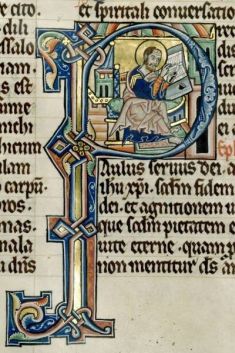Production of illuminations
During the writing process, the scribe would leave some space for an illuminator to add in the initials or miniatures. One will often find a large initial space where the scribe will have indicated to the illuminator what initial must be drawn in that space. However, it is even more common to find entirely blank spaces instead of initials, for example in AM 228 fol. Bigger manuscripts may also contain instructions for larger illuminations. The illumination of a manuscript seems therefore to have been something that was planned ahead hand in hand with the choice of format and text.
The amount of illuminations in the manuscript also depended highly on the clients' financial possibilities and the material available. Is is thinkable, then, that the illuminator participated in the laying out of the manuscript in order to determine and set the limits for the creative possibilities. The illuminator started out with drawing the contours of the illuminations with a pen or a pencil before adding colour to them. The illuminator was usually an artist who didn't get to decide what the illuminations would look like. In manuscript culture, copying was not something to be afraid of and this applied to illuminations too. In fact, it was perhaps even more prestigious to be skilled at copying drawings than creating new drawings.
Why?
Older books had, unlike books nowadays, a much freer design of the text layout. Chapter, paragraph or sentence initials were allowed to take up the space of as little as two lines in height or even an entire page. One could also opt for sentences written in red (rubrics) to indicate the beginning of a new section in the text.
Miniatures could also help to make the book more user-friendly by illustrating episodes in a text. See for example this picture of the crucifixion in AM 421 12mo which could contribute to the reader's devotion. Another reason for using miniatures was also to help locate the desired chapter in a book.
Colours
In some cases, the colours of the illuminations was already decided before the illumination began. They could be made from various ingredients, from animals or plants, or from more surprising ingredients such as urine or earwax.
Black pigment: can be made of coal, squid ink, soot, vitriol.
White pigment: can be made of af chalk, plaster, chinese clay, bone powder, white lead.
Yellow pigment: can be made of saffron, turmeric, ochre, orpiment.
Red pigment: can be made of alkanna (plant), orseille (lichen), Tyrian purple (from mollusks), cochineal.
Green pigment: can be made of blackberry, sloe bush, iris, malachite.
Blue pigment: can be made of woad, leaves from the indigo plant, extract from sunflower seeds, azurite.
The Hamburg Bible - illuminations
The Hamburg Bible from The Royal Library in Copenhagen, Denmark shows the various steps in book production in its illuminations. See more pictures of the Hamburg Bible on UNESCO's website.

